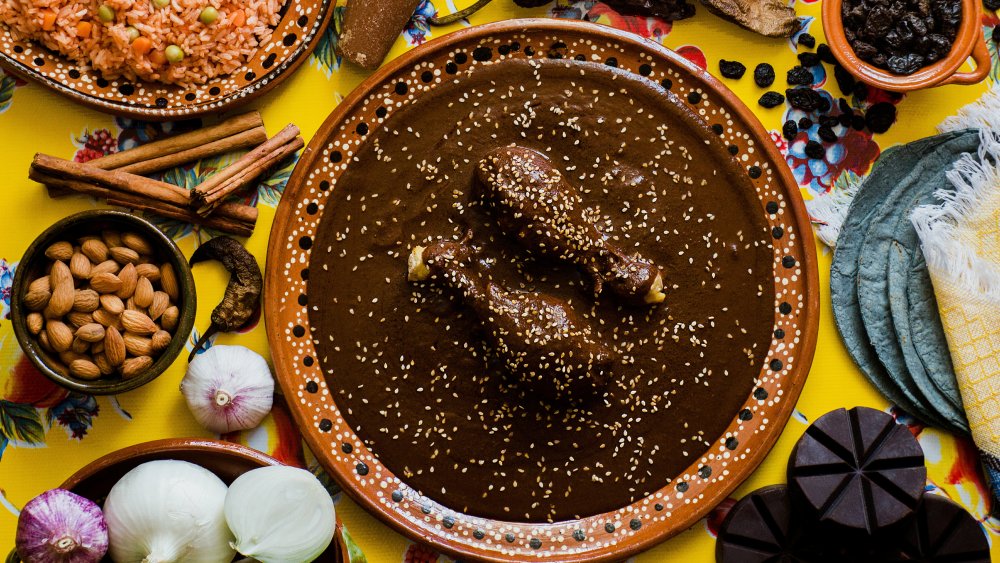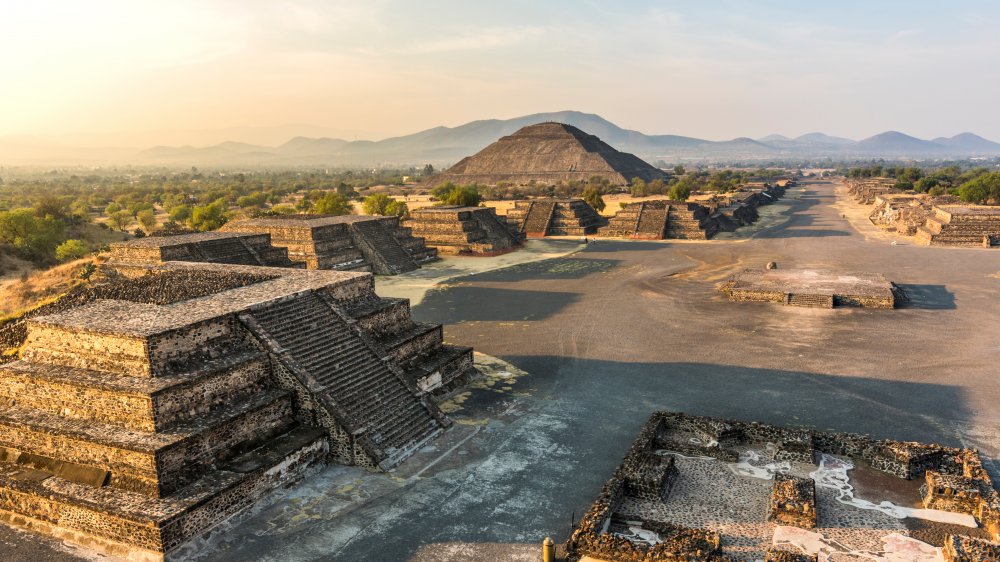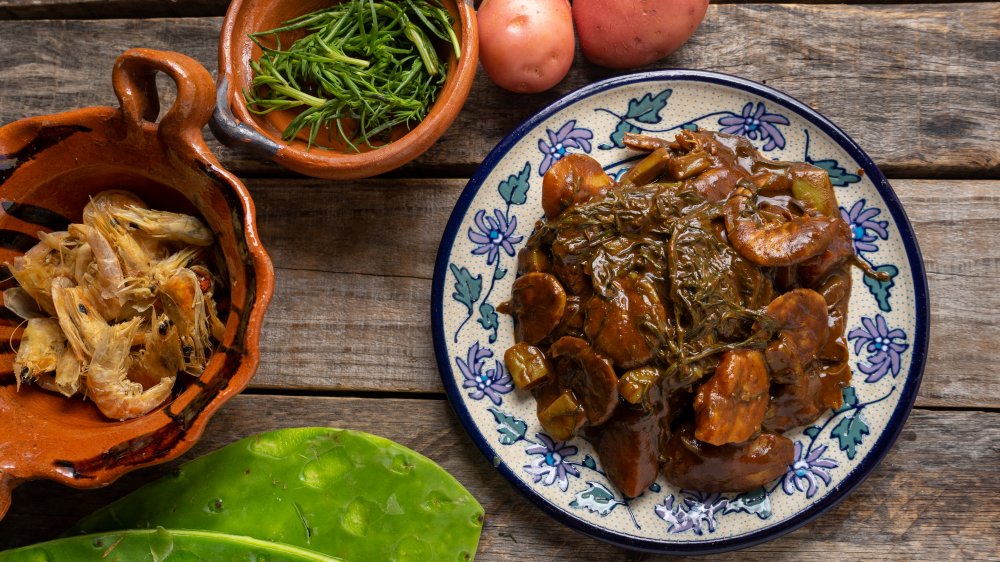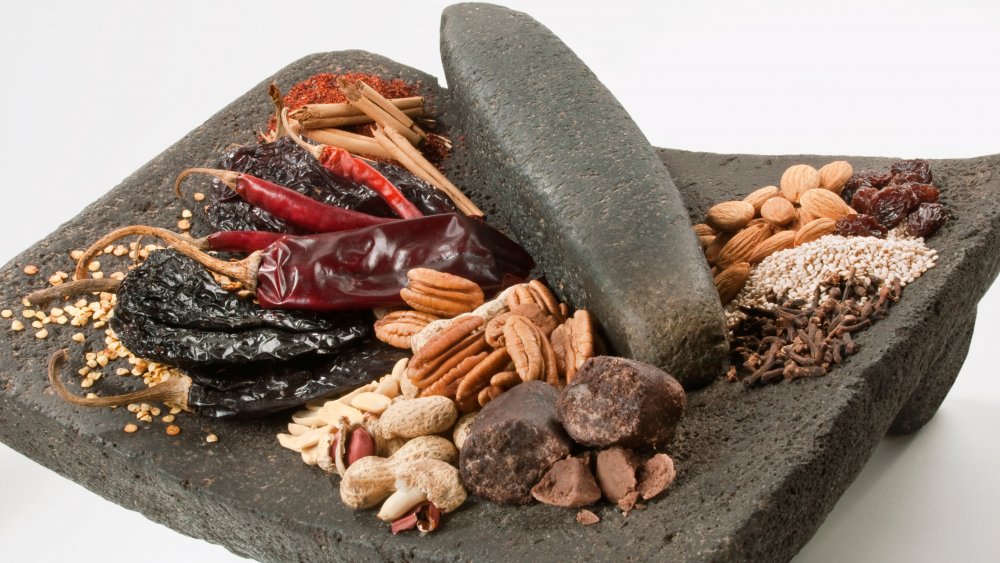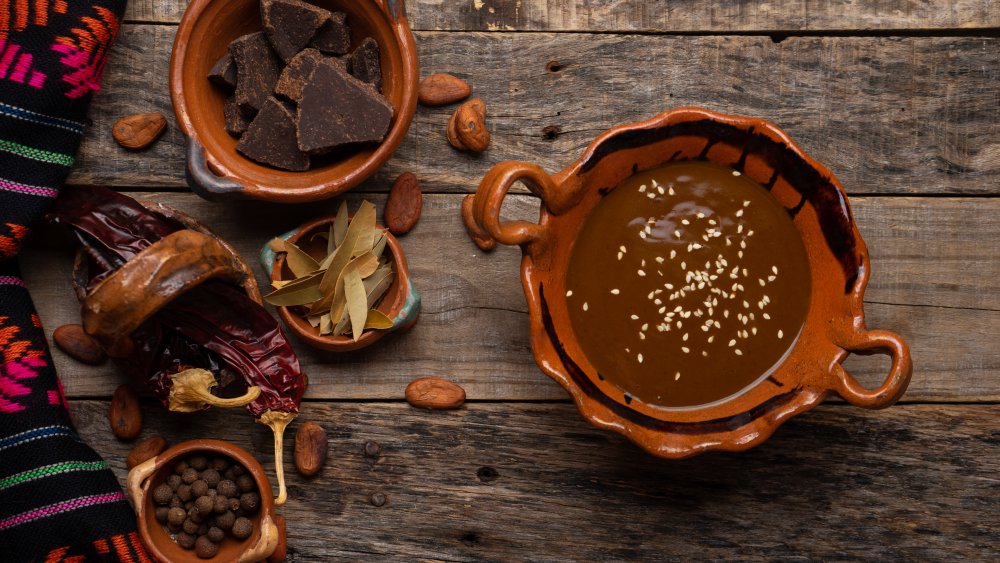The Untold Truth Of Mole
Walking into any authentic Mexican restaurant, you are bound to find mole. Mole, pronounced MOH-lay, is a chocolate-based sauce (in some cases) that when done correctly could almost wipe away all of your woes. Considered to be one of Mexico's first international dishes, mole holds a special place in the cultural history of the vibrant country it calls home (via Benito's Mexican restaurant). This sauce was seen as something that was special, shared between families at special events and celebrations.
According to Allrecipes, there are seven types of mole, each being just as unique as the last. Being that it is a sauce, it can technically be paired with just about anything. But, like many sauces, especially one that is this complex in flavors, mole can come alive in an incredible way if you pair it with the right meat or dish. For example, Mole Poblano sings with braised beef or pork, while Mole Manchamantel dances to a different tune when served with chicken.
The word mole has indigenous roots
Before the Spanish touched the land that we now call Mexico, there were many pre-Columbian indigenous tribes – think the Mayans, Aztecs, and Olmecs – that lived in the area (via History). In both of the origin stories that surround mole, the actual origin of the world can be traced back to the Nahuatl word "mulli," which translates as "sauce" (via America's Test Kitchen). Today's version of the Nahuatl language stems from the more ancient Uto-Aztecan language family, which was spoken by the Aztec culture (via Langshack).
The Nahuatl language is still spoken in Mexico, but only in certain areas, mainly surrounding present-day Mexico City. But the Uto-Aztecan language family is much more widespread than most would think, as it stretched as far north as the US and can be found within the Comanche, Hopi, and Paiute languages. The Nahuatl language has even influenced words in present-day Spanish, such as "coyote," aguacate (avocado), "elote" (corn), and "chocolate."
Mole has different alleged origin stories
Mole's origin story is just as beautifully complex as the sauce itself. There are different legends, one of which claims that it was created by nuns (via Culture Trip). As the story goes, mole was invented at a convent in Puebla, Mexico when an archbishop stopped for a visit. The nuns were said to have panicked a bit by the visit, as they had very little to offer their honored guest. They proceeded to butcher an old turkey they had added nuts, chili peppers, stale bread, and spices to help make the meat taste better (via Benito's Mexican restaurant). Somewhere along the way, chocolate was added to the rest of the ingredients.
Another mole legend dates back to the time of Moctezuma and the Spanish conquistador Hernán Cortés. It is said that the Aztecs confused Cortés for a god and served him the dish. The true origin has been long debated, as the first recorded recipes were written sometime after the War of Independence in the early 1800s. Despite Oaxaca and Puebla being the two regions best known for mole, the region of Tlaxcala claims mole originated there.
What goes into a mole sauce?
Moles can be complex and take quite some time to achieve due to the intensive cooking process. Typically, a mole features a variety of chiles and seasonings that are slowly cooked down to reveal a multilayered sauce. For example, Mole Poblano requires a variety of dried chiles (guajillos, pasillas, anchos, and chipotles), several spices, a plethora of seasonings, and chocolate to achieve the perfect taste (via America's Test Kitchen). All in all, a typical Mole Poblano could use more than 20 different ingredients (via Closet Cooking).
Regardless of the mole you choose to make, many require similar base ingredients like dried chilies, fruits, nuts, and spices (and depending on the sauce, sometimes chocolate) – all of which are ground and added to the pot as you cook it down into a creamy sauce (via Taste of Home). By all accounts, mole never tastes like any one ingredient – "it tastes like mole."
So, which mole should you try?
Although Mole Poblano is one of the most popular versions in the US, mole has seven main variations. They are Mole Poblano, Mole Negro, Mole Coloradito, Mole Amarillo, Mole Manchamantel, Mole Chichilo, and Mole Verde (via El Paso Mexican Restaurants).
Mole Poblano, regarded as the national dish of Mexico, is red due to the dried chilies found in it. Mole Negro, which translates to "black mole," contains chocolate and is somewhat bitter and sweet. Mole Coloradito, which translates to colored mole, is typically served with enchiladas and is fruitier in taste. Mole Amarillo, which translates to yellow mole, is made with spices like dried guajillo chiles and has no chocolate.
Mole Manchamantel, the only version with actual meat in it, packs a more savory taste since it is made with various sausages, tomatoes, and ancho chiles. Mole Verde, which translates to "green mole," is a bit spicier since it contains jalapeños and has tomatillos, cilantro, and pumpkin seeds. Mole Chichilo, the rarest of the moles because it is used for special events, is made with beef stock and cornflour, so it will be more savory. In the end, there is no wrong choice that can be made, as each mole is rich and flavorful and sure to delight.
